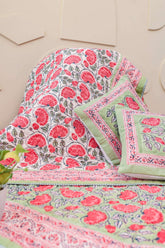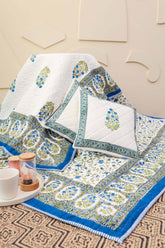Mujhko bhi tarkeeb sikha koi yaar juu’lahy (juu’lahy = cloth weaver) Aksar tujhko dekha hai ek tana bunn’te Jab koi dhaga toot gaya ya khatam hua Phir se baandh ke aur sira koi jodh ke us mein Aage bunnne lagte ho Tere is ta’ne mein lekin Ik bhi gaanth girah buntar ki dekh nahi sakta hai koi Maine to ek baar bunna tha ek hi rishta Lekin uski saari girhain saaf nazar aati hain mere yaar juu’lahy” Mujhko bhi tarkeeb sikha koi yaar julahey -Gulzar
Can there be a more fitting way to describe a weaver‘s craft- the love, care and perseverance with which he nurtures his yarn? For over 30,000 years, India has been home to several such skilled artisans who with their spellbinding intricacies have woven out an immensely rich and diverse textile tradition.
A land so consistent in its diversities, inevitably has the most compelling of stories to tell. Most of these are celebrations of our differences that form the very fabric of our unique regional identities. Every region lays bare its own distinctive styles clad in the most delightful of customs and traditions. And what better way to express and revel in such exquisite cultural nuances than donning these close to our hearts! One such tradition to have been born out of our heterogeneous heritage is the Ikat tradition of dyeing and weaving.
Ikat, an ingenious, immersive and intricate technique has some equally intricate origins. Many believe that the mesmerizing mishmash of motifs and patterns emerged simultaneously and independently across the globe. While it is rather tricky to trace the original birthplace of the prestigious Ikat, it is largely acknowledged that the tradition has a strong Asian lineage and leaning. India, Indonesia, parts of Central Asia and Maritime Southeast Asia are among the most prominent candidates to have conceived the Ikat Tradition.
The elaborate dyeing and weaving process of this truly ethereal handloom technique is nothing short of a poetry of the loom. Gulzar aptly describes the toil of the weaver by drawing parallels with the demands of weaving a relationship. It is essentially this relationship of care, sensitivity, and patience of the artisan with its loom that yields such a beautiful result. This especially holds true for Ikat for its immensely complex and painstaking technique.
What makes Ikat rather interesting, is the layers of unique process the artform undergoes. One of the most striking aspects of this traditional textile lies in the process of dyeing the patterns before weaving the yarn into cloth. Oodles of carefully bunched thread is first tightly wrapped together on a frame and dyed several times to create delicate pattern. The artisan then meticulously lets the yarn dry up before carefully aligning these on the loom where the design finally takes form while being woven into fabric. Any misprint or lightness of the pattern costs the artisan to restart the entire process right from the bundling of the threads.
What’s truly delightful here is how this resist dyeing technique alters based on the type (single, double, mixed) and the region it comes from. In the Indian context, resist dyed Ikat textiles originate in 3 major corners. The renowned trousseau worthy “Patolas” with their characteristic double ikat patterns come from Gujarat. These undergo resist dyeing on both the warp and weft sides and are soaked at distinct parts before these are matched on the loom. Patola sarees garner great appeal during the festivities and have class, grace and prestige written all over. A patola is often the most loved handloom possession for most saree wearers, art lovers and new brides across the globe. Apart from the Patolas, Sambhalpuris from Orissa and Pochampallisfrom Telangana are the other two places that incorporate the resist dyed technique. Sambhalpurisoften wear the motifs of flora and fauna or local deities while offering a great canvas for the artisans to express themselves in unique ways that are potential of multiple interpretations.
Ikat textiles are not just bleeding patterns of crisscrosses through the length and breadth of a cloth. From a beautifully crafted handkerchief with double ikat design to six yards of complex and unique regional motifs, Ikat is more than just a type of dyeing and weaving technique. Each creation that stems from the Ikat tradition is a result of sophisticated workmanship, fine artistry, meticulous detail, and an immense amount of hard work!














